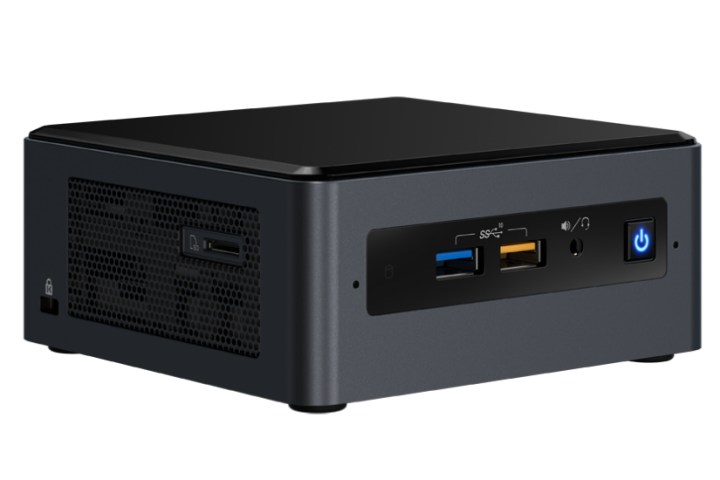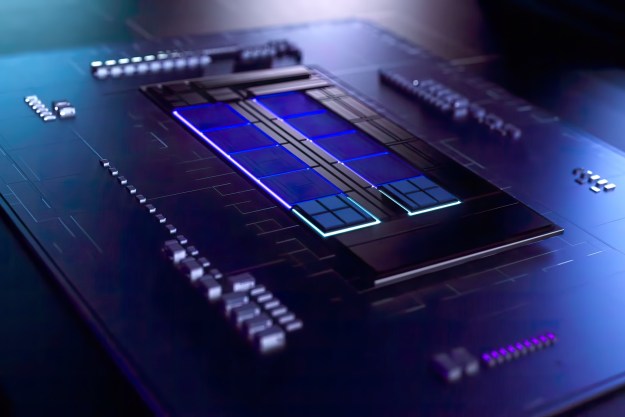
If you’re looking for a super-compact PC for streaming media that doesn’t break the bank, Intel updated its Next Unit of Computing (NUC) family with new “Bean Canyon” kits. Currently, there are five units packing Intel’s eighth-generation Core “Coffee Lake-U” processors released in April. But drawback with these “barebones” NUCs is that memory, storage, and the operating system are an additional cost on top of NUC’s original price tag. You’ll need a display and peripherals too.
If you’re not familiar with NUCs, they are miniature PCs that are designed to mount behind a desktop monitor or blend into your office environment or entertainment center unnoticed. They’re small and quiet yet powerful enough to possibly serve as a desktop replacement, depending on your needs. They’re typically provided in two compact sizes, one of which is larger than the other to accommodate additional storage.
Intel now serves up five affordable Bean Canyon NUCs: Two based on the Core i3-8109U for $300, two based on the Core i5-8259U for $400, and one based on the Core i7-8559U for $500. Technically, these chips were designed for mobile, but they don’t require excessive amounts of cooling, keeping the NUC’s noise level down to a minimum.
Here’s the new Bean Canyon family:
As an example of the size differences, the NUC8i5BEK model only supports a single stick-shaped M.2 SSD while the NUC8i5BEH provides enough space to support a stick-shaped M.2 SSD and a 2.5-inch hard drive or SSD. Yet both provide two empty memory slots supporting up to 32GB of DDR4 system memory clocked at 2,400MHz.
Port-wise, both units are identical despite their different physical sizes. On the back, they provide one HDMI 2.0a port, two USB-A ports (5Gbps) and a Thunderbolt 3 port (40Gbps). On the front, you will see two USB-A ports (one of which will charge devices), headphone/microphone combo jack, and dual-array front microphones. A Micro SD card slot is located on the left side. For connectivity, the NUCs provide a gigabit Ethernet port on the back, Bluetooth, and Wireless AC networking.
You’ll see this same port and connectivity setup across all five Bean Canyon NUCs. All models support a maximum three external displays despite the Thunderbolt 3 port, all of which are handled by the integrated graphics in Intel’s CPUs. If you’re looking for compact gaming machines with discrete graphics, the company’s more-expensive “Hades Canyon” units would be a better option.
If you don’t want to be bothered with installing the memory and storage, and simply want to purchase these NUCs as complete PCs, SimplyNUC is taking pre-orders now for units what will ship in October.
For instance, a fully configured NUC8i7BEH with 8GB of memory, 128GB of storage, and a free installation of Windows 10 will cost $720. Maxing out the options can send the final price above $4,000 such as adding a 2TB M.2 SSD, a 4TB SSD and 32GB of memory. That doesn’t include tacking on peripherals or an extended warranty.
Editors' Recommendations
- Intel’s Core Ultra CPUs are more Apple, less AMD
- Intel’s 14th-gen Raptor Lake refresh might be a major disappointment
- Intel Raptor Lake CPUs: Everything we know about the 13th-gen processors
- Intel Raptor Lake sets a sizzling new record for clock speeds
- Leak confirms Intel Raptor Lake may bring huge core increase
